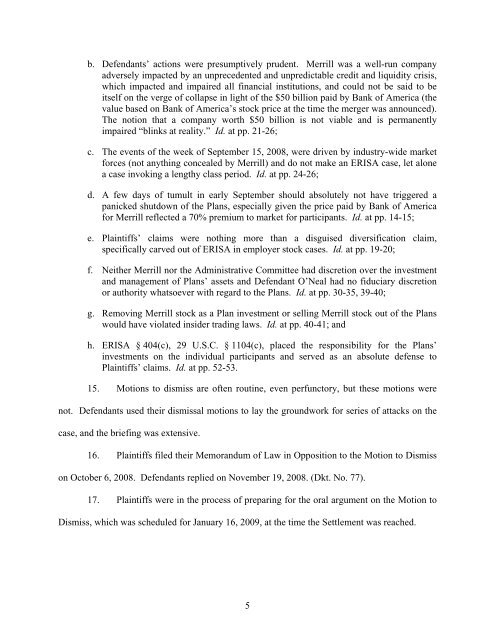Joint Declaration of Lynn L. Sarko and Marc I ... - Cohen Milstein
Joint Declaration of Lynn L. Sarko and Marc I ... - Cohen Milstein
Joint Declaration of Lynn L. Sarko and Marc I ... - Cohen Milstein
You also want an ePaper? Increase the reach of your titles
YUMPU automatically turns print PDFs into web optimized ePapers that Google loves.
. Defendants’ actions were presumptively prudent. Merrill was a well-run company<br />
adversely impacted by an unprecedented <strong>and</strong> unpredictable credit <strong>and</strong> liquidity crisis,<br />
which impacted <strong>and</strong> impaired all financial institutions, <strong>and</strong> could not be said to be<br />
itself on the verge <strong>of</strong> collapse in light <strong>of</strong> the $50 billion paid by Bank <strong>of</strong> America (the<br />
value based on Bank <strong>of</strong> America’s stock price at the time the merger was announced).<br />
The notion that a company worth $50 billion is not viable <strong>and</strong> is permanently<br />
impaired “blinks at reality.” Id. at pp. 21-26;<br />
c. The events <strong>of</strong> the week <strong>of</strong> September 15, 2008, were driven by industry-wide market<br />
forces (not anything concealed by Merrill) <strong>and</strong> do not make an ERISA case, let alone<br />
a case invoking a lengthy class period. Id. at pp. 24-26;<br />
d. A few days <strong>of</strong> tumult in early September should absolutely not have triggered a<br />
panicked shutdown <strong>of</strong> the Plans, especially given the price paid by Bank <strong>of</strong> America<br />
for Merrill reflected a 70% premium to market for participants. Id. at pp. 14-15;<br />
e. Plaintiffs’ claims were nothing more than a disguised diversification claim,<br />
specifically carved out <strong>of</strong> ERISA in employer stock cases. Id. at pp. 19-20;<br />
f. Neither Merrill nor the Administrative Committee had discretion over the investment<br />
<strong>and</strong> management <strong>of</strong> Plans’ assets <strong>and</strong> Defendant O’Neal had no fiduciary discretion<br />
or authority whatsoever with regard to the Plans. Id. at pp. 30-35, 39-40;<br />
g. Removing Merrill stock as a Plan investment or selling Merrill stock out <strong>of</strong> the Plans<br />
would have violated insider trading laws. Id. at pp. 40-41; <strong>and</strong><br />
h. ERISA § 404(c), 29 U.S.C. § 1104(c), placed the responsibility for the Plans’<br />
investments on the individual participants <strong>and</strong> served as an absolute defense to<br />
Plaintiffs’ claims. Id. at pp. 52-53.<br />
15. Motions to dismiss are <strong>of</strong>ten routine, even perfunctory, but these motions were<br />
not. Defendants used their dismissal motions to lay the groundwork for series <strong>of</strong> attacks on the<br />
case, <strong>and</strong> the briefing was extensive.<br />
16. Plaintiffs filed their Memor<strong>and</strong>um <strong>of</strong> Law in Opposition to the Motion to Dismiss<br />
on October 6, 2008. Defendants replied on November 19, 2008. (Dkt. No. 77).<br />
17. Plaintiffs were in the process <strong>of</strong> preparing for the oral argument on the Motion to<br />
Dismiss, which was scheduled for January 16, 2009, at the time the Settlement was reached.<br />
5


